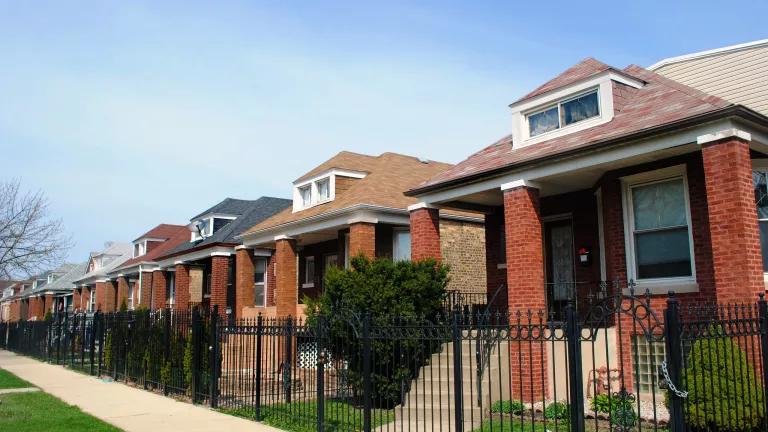2022: A Banner Year for Building Decarbonization
There is a lot to celebrate when it comes to improved building decarbonization policies in 2022.

As we close out a busy year, there is a lot to celebrate when it comes to improved building decarbonization policies. While the passage of legislation that makes the biggest-ever investment in our nation’s buildings certainly takes the cake, there has also been lots of significant work happening at the state level and in the development of appliance standards that promote building decarbonization. When it comes to decarbonizing our new buildings, advocates have been working hard all year to develop the latest model energy code, and the Federal government has stepped up its efforts on both new and existing buildings.
Energy Codes: Progress and Compromise
Energy code development looks a lot different this year than it has in previous years. Rather than being developed through a public process where governmental officials have the final say on what makes it into the code, the process for model energy code development is now driven by two consensus committees, one to handle the residential portion of the code and another working on the commercial code provisions. NRDC staff holds voting membership on each of these committees and has been instrumental in influencing proposals that will hopefully result in a code that saves energy AND reduces carbon emissions.
The committees are currently considering public comments submitted on the first draft of the code. While the final code will not be complete for a few months, there were several promising proposals that were accepted into the draft code, including the following:
- Electric vehicle infrastructure readiness requirements for both commercial and residential buildings
- Solar-readiness requirements for commercial and residential buildings (with exceptions for shaded residential roofs)
- Electric-readiness requirements for homes built with fossil-fuel burning water heaters, cooking appliances, and clothes drying, which would make future electrification of these appliances significantly cheaper and easier
- A credit-based system for incorporating additional efficiency requirements for residential new construction
- Grid integration requirements for thermostats and water heaters in commercial buildings
It has taken substantial compromise to get to this point – but we still see more room for cost-effective energy efficiency improvements in the code. A strong building envelope is critical to ensuring efficient electrification, and some of the proposals voted down by the committee are common-sense, cost-effective improvements that should be incorporated into the final code. These include demand response capable thermostats, improvements in air leakage and building ventilation, and a building envelope that is strengthened – not weakened – compared to the current model code.
It is crucial that the 2024 energy code be a true improvement over the 2021 code. Not only are improved new buildings crucial to meet our climate goals, but the Inflation Reduction Act includes $1 billion of new funding for jurisdictions that adopt codes that are at least as efficient as the 2021 code (with most funding available for meeting a zero energy stretch code). If the 2024 International Energy Conservation Code (IECC) fails to be as efficient as the 2021 IECC, states adopting it would not be able to tap into that massive federal funding.
We have also seen great research this year that solidifies what we have known for a number of years: building homes to be efficient and all-electric from the start is more economical and has lower lifetime emissions than buildings built with on-site fossil fuels. An updated study from RMI shows that, across nine studied geographies, all-electric new homes cost less upfront to build, have lower annual operating costs, and have substantially lower 15-year carbon emissions, even if gas continues to provide a significant share of electricity generation. While we are still in the middle of the code development process, we are optimistic that the 2024 model codes will result in efficient buildings that are ready for decarbonization, once the code is finalized in mid-2023.
Local jurisdictions can start planning now to update their energy codes. The Department of Energy just released a Funding Opportunity Announcement for $225 million from the Bipartisan Infrastructure Law, to support the implementation of resilient and efficient energy codes. Along with the $1 billion that's still to come to support code adoption, there has never been a better time to transform how new buildings are constructed.
Federal Buildings Will Lead the Way
We are not just seeing momentum on electrifying new homes: earlier this month, the Department of Energy announced a proposed rule to electrify new or renovated Federal buildings. Starting in 2025, federal facilities will be required to reduce site emissions from the building’s energy consumption by 90 percent relative to 2003 levels, with full decarbonization required by 2030. This action by the Federal government – the country’s single-largest energy consumer and building manager - sends a clear signal that not only is decarbonization of new buildings fundamentally needed to achieve our climate goals, decarbonizing these buildings is both feasible and achievable. There is no reason for privately-owned buildings not to quickly follow suit.
The Federal government is also addressing the energy and climate performance of the 300,000 existing Federal buildings, by adopting the first-ever Federal Building Performance Standard. The Standard sets a goal to cut energy use and electrify appliances and equipment in 30 percent of the Federally-owned building space by 2030. Recognizing the importance of building performance standards, which have been used as a policy tool at the local level for years to address the energy use of existing buildings, the Biden-Harris administration also announced the National building Performance Standard Coalition earlier in 2022. These performance standards work by setting deadlines for building energy (or carbon) performance benchmarks over the long term, which drives change while allowing building owners flexibility to meet the targets. As a major real estate holder, this “lead by example” action by the Federal government will help drive the market toward products and services that promote greater efficiency and lower emissions in existing buildings.
This was a banner year for policies promoting building decarbonization, but the real work has only just begun. Let’s keep it up in 2023!



